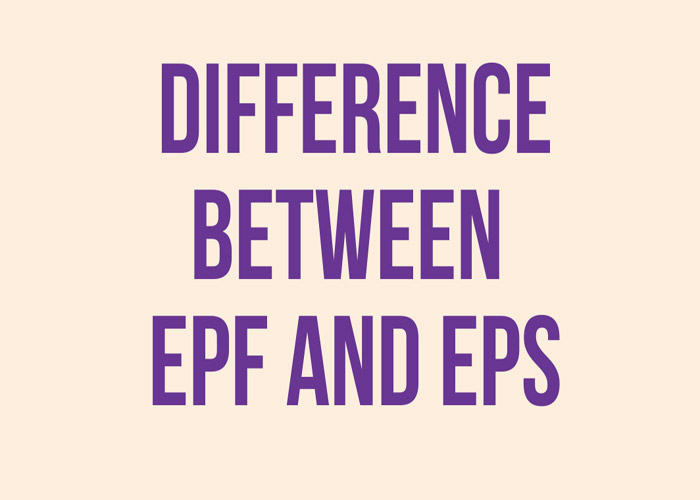How are EPF and EPS different?
EPF and EPS are amongst the common terms that everyone is aware of. Both of these come under the Employee’s Provident Fund & Miscellaneous Provisions Act, 1952. EPF refers to Employee’s Provident Fund (EPF) whereas EPS refers to Employee Pension Scheme. Both the schemes are managed by the central board of trustees, comprising government representatives (central and state), employees, and employers. Let’s understand in detail the difference between EPF and EPS. EPF and EPS are both retirement benefit plans, but still, they are different. The below table will give you a detailed understanding:
Difference between EPF and EPS:
| Parameter | EPF | EPS |
| Contribution from the Employee | 12% of basic salary and dearness allowance | Nil |
| Contribution from the Employer | 3.67% of basic salary and dearness allowance paid to the employee | 8.33% of the basic salary and dearness allowance paid to the employee |
| Eligible employees | All | Employees whose salary + dearness allowance is up to Rs 15,000 |
| Interest on investment | The interest is calculated every month and paid at the end of the Financial Year. The interest rates are fixed and reviewed by the government on a regular basis | No interest is paid towards the EPS account |
| Maximum contribution | 12% on the salary. | The Contribution is limited to 8.33% on salary up to Rs.15,000, i.e. Rs. 1250 |
| Tax | Interest received on the EPF account is exempted. But if the contribution is more than Rs 2.5 lakh in a year, then the excess amount is taxable. However, there is no tax on the principal amount redemption. If the balance amount in EPF is withdrawn before 5 years, then TDS @10% is deducted. | Pension and lump-sum amounts both are taxable when received. |
| 80C deduction | Deduction on up to Rs.1.5 lakh of employee’s contribution | No deduction is allowed as employee contribution is Nil |
| Premature Withdrawal | Partial withdrawal is possible for certain cases like marriage loan repayment, education of children, unemployment, etc., if specific criteria are fulfilled. | An early pension can be received after 50 years. Also, if an individual attains 58 years of age or service is completed in less than 10 years whichever is earlier, a lump-sum amount can be withdrawn. |
| Premature Withdrawal amount | Full EPF balance can be withdrawn | The amount can be withdrawn depending upon the years of service. |
What is an Employee Provident Fund (EPF)?
Employee Provident Fund is a scheme that encourages savings for the retirement of an individual. Under the EPF scheme, both the employer and the employee of an organization or company contribute towards the employee’s provident fund account. The contributed amount gets accumulated throughout the entire working period of the individual, and the employee can withdraw the amount in lump-sum with interest-only after retirement from a regular job. One can withdraw 75% of the accumulated EPF corpus after one month of leaving the job and the remaining 25% after two months of exit.
An individual can also apply for PF withdrawal before the maturity period. Still, only in special cases such as marriage, loan repayment, children’s education, unemployment, etc. In case the EPF amount is withdrawn before the completion of 5 years, the 10% tax gets deducted.
EPF provides regular interest on investments made towards the EPF account. The interest rate offered on the EPF account in the financial year 2019-20 is 8.5%. Each employee and employer’s contribution in the EPF account shall be 12% of the employee’s salary (dearness allowance and basic salary.
Who is eligible for EPF?
- EPF applies to companies and organizations’ workforce that comes under the Employees’ Provident Fund Organisation (EPFO).
- EPF is mandatory for organizations and companies comprising more than 20 employees.
- EPF is mandatory for salaried employees earning up to Rs 15,000 salary (basic + dearness allowance).
- Employees earning over Rs.15,000 salary can voluntarily contribute to the EPF scheme.
What is the Employee Pension Scheme (EPS)?
EPS refers to the Employee Pension Scheme wherein the scheme pays a pension to those employees who are EPFO members and have contributed towards the EPS account. Upon the demise of an employee, the pension is paid to the nominee on a regular basis. Employees don’t contribute towards the EPS account, whereas the employer’s contribution is 8.33% of the employee’s basic salary and dearness allowance. The employee receives a pension from such a scheme after the age of 58 years.
The monthly pension is calculated through below mention formula:
Monthly pension = (Average last 12 months salary x No. of years worked )/70
An individual can withdraw the lump-sum amount from EPS only in case of two situations
- If the EPS member quits the job before 10 years of completion of service.
- If the member has attained the age of 58 years.
In case the EPS member quits from his or her employment in less than 10 years in service at the age less than 58 years, he or she can choose to get a scheme certificate to join another job while retaining the EPFO membership. The scheme certificate is issued to the EPS member after the completion of 10 years of service. An individual can also apply for the scheme certificate if he or she withdraws the EPF contribution and wants to receive the pension benefits after the age of 58 years.
Is it possible to transfer EPF or EPS accounts?
The members of the scheme are allotted a Universal Account Number (UAN) by the Employees Provident Fund Organisation (EPFO). The UAN remains the same throughout the employment life of the member, and through the same UAN, all other relevant details can be accessed. Suppose an individual changes his or her job, the UAN does not change, and the employee can continue contributing to the EPF account. In that case, however, he or she needs to update the UAN number to the new employer. To transfer funds online, an individual needs to activate UAN and link aadhaar and PAN with it.
After going through this write-up, I hope you have understood the difference between EPF and EPS. Both are useful and essential tools to plan a secure retirement life without being financially insecure. Hence, if you are planning for your life after retirement then do consider investing in EPF or EPS.





























